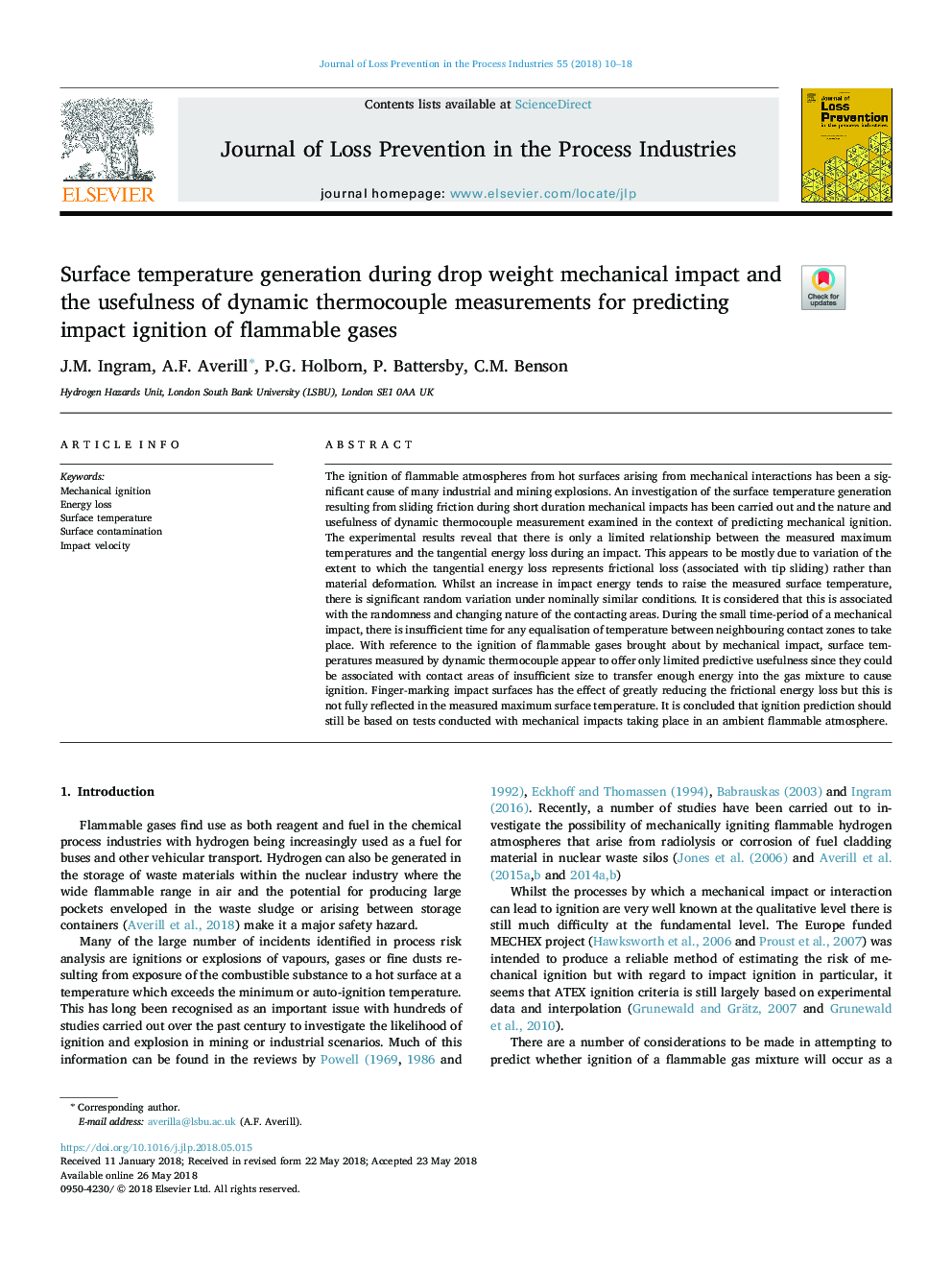| کد مقاله | کد نشریه | سال انتشار | مقاله انگلیسی | نسخه تمام متن |
|---|---|---|---|---|
| 6972741 | 1453253 | 2018 | 9 صفحه PDF | دانلود رایگان |
عنوان انگلیسی مقاله ISI
Surface temperature generation during drop weight mechanical impact and the usefulness of dynamic thermocouple measurements for predicting impact ignition of flammable gases
ترجمه فارسی عنوان
نسل سوم دمای زمین در اثر ضربه مکانیکی قطره وزن و سودمندی اندازه گیری های ترموکوپل پویا برای پیش بینی آتش سوزی گازهای قابل اشتعال
دانلود مقاله + سفارش ترجمه
دانلود مقاله ISI انگلیسی
رایگان برای ایرانیان
کلمات کلیدی
احتراق مکانیکی، از دست دادن انرژی، دمای سطح، آلودگی سطحی، سرعت ضربه
ترجمه چکیده
احتراق جوهای قابل اشتعال از سطوح داغ ناشی از تعاملات مکانیکی، عامل مهمی برای بسیاری از انفجارهای صنعتی و معدنی بوده است. تحقیق در مورد میزان تولید درجه حرارت حاصل از اصطکاک کششی در طول تاثیرات مکانیکی کوتاه مدت انجام شده است و ماهیت و مفید بودن اندازه گیری ترموکوپل پویا در زمینه پیش بینی اشتعال مکانیکی مورد بررسی قرار گرفته است. نتایج تجربی نشان می دهد که تنها بین معادلات حداکثر اندازه گیری شده و تلفات انرژی مماسی در طول ضربه، تنها رابطه محدودی وجود دارد. به نظر می رسد که این امر عمدتا به علت تغییرات در میزان ناپایداری انرژی مماسی، نشان دهنده از دست رفتن اصطکاک (همراه با نوک کشویی) به جای تغییر شکل ماده است. در حالی که افزایش انرژی ضربه به افزایش دمای سطح اندازه گیری شده است، تغییرات تصادفی قابل توجهی در شرایط مشابه به طور مشابه وجود دارد. در نظر گرفته شده است که این به طور تصادفی و طبیعت در حال تغییر مناطق تماس است. در طول دوره زمانی کوتاهی از تأثیر مکانیکی، زمان کافی برای مقایسۀ دمای بین مناطق تماس نزدیکی وجود ندارد. با توجه به احتراق گازهای قابل اشتعال بوسیله تأثیر مکانیکی، درجه حرارت سطح توسط ترموکوپل دینامیک به نظر می رسد که تنها سودمندی پیش بینی محدود را ارائه می دهد، زیرا می تواند با مناطق تماس با اندازه کافی همراه باشد تا انرژی کافی برای مخلوط گاز ایجاد شود تا باعث ایجاد اشتعال شود. سطوح ضربه زدن به انگشتان اثر تا حد زیادی باعث کاهش ضرر انرژی اصطکاکی می شود اما این به طور کامل در دمای حداکثر سطح اندازه گیری نشده است. نتیجه گیری می شود که پیش بینی اشتعال هنوز باید بر اساس آزمایشات انجام شده با تأثیرات مکانیکی که در فضای قابل اشتعال محیط انجام می شود، باشد.
موضوعات مرتبط
مهندسی و علوم پایه
مهندسی شیمی
بهداشت و امنیت شیمی
چکیده انگلیسی
The ignition of flammable atmospheres from hot surfaces arising from mechanical interactions has been a significant cause of many industrial and mining explosions. An investigation of the surface temperature generation resulting from sliding friction during short duration mechanical impacts has been carried out and the nature and usefulness of dynamic thermocouple measurement examined in the context of predicting mechanical ignition. The experimental results reveal that there is only a limited relationship between the measured maximum temperatures and the tangential energy loss during an impact. This appears to be mostly due to variation of the extent to which the tangential energy loss represents frictional loss (associated with tip sliding) rather than material deformation. Whilst an increase in impact energy tends to raise the measured surface temperature, there is significant random variation under nominally similar conditions. It is considered that this is associated with the randomness and changing nature of the contacting areas. During the small time-period of a mechanical impact, there is insufficient time for any equalisation of temperature between neighbouring contact zones to take place. With reference to the ignition of flammable gases brought about by mechanical impact, surface temperatures measured by dynamic thermocouple appear to offer only limited predictive usefulness since they could be associated with contact areas of insufficient size to transfer enough energy into the gas mixture to cause ignition. Finger-marking impact surfaces has the effect of greatly reducing the frictional energy loss but this is not fully reflected in the measured maximum surface temperature. It is concluded that ignition prediction should still be based on tests conducted with mechanical impacts taking place in an ambient flammable atmosphere.
ناشر
Database: Elsevier - ScienceDirect (ساینس دایرکت)
Journal: Journal of Loss Prevention in the Process Industries - Volume 55, September 2018, Pages 10-18
Journal: Journal of Loss Prevention in the Process Industries - Volume 55, September 2018, Pages 10-18
نویسندگان
J.M. Ingram, A.F. Averill, P.G. Holborn, P. Battersby, C.M. Benson,
